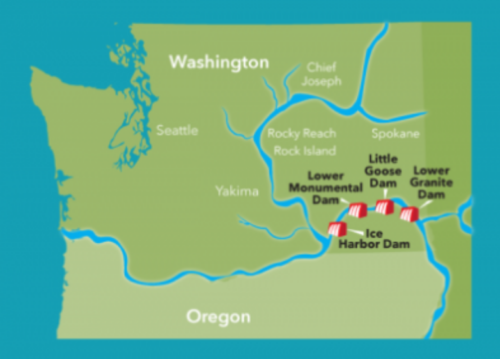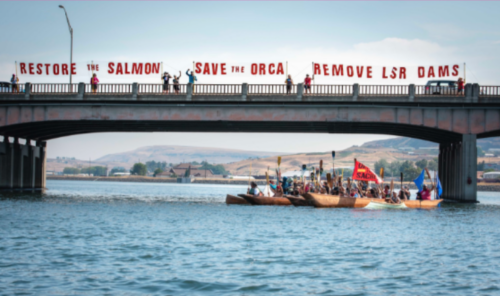Menu
ESI Stories
The ESI’s Rapid Response Group Engages Climate Justice Issues in the Snake River Region
September 2, 2023
By: Ty Rogers, ESI Intern and Briana Meier, Postdoctoral Associate
This summer, following the the ESI Climate Justice Program team’s visit to San Juan Island in April to meet with project partners at the Indigenous-led nonprofit Se’Si’Le, we organized a student research project in support of Se’Si’Le’s efforts to restore Pacific salmon and orca populations, and advocate for tribal-led conservation in the Pacific Northwest. We recruited undergraduate student researchers through the ESI Rapid Response Group (RRG), which is an ongoing ESI initiative formed to respond to critical environmental issues in a timely manner with science-based analysis and assistance in service to ESI’s partners.
From June through August, five RRG students investigated urgent issues around the lower Snake River dams, Pacific salmon and orca recovery, and tribal sovereignty. During these months, negotiations have been underway to settle a federal lawsuit filed in 2020 by the Nez Perce tribe, other tribes, and a coalition of conservation organizations. On Aug. 31, a “stay in litigation” was extended for another 60 days, meaning that the parties to the lawsuit have until the end of October to come to an agreement. At the time of publication, no announcement has been made about extending the federal public comment period, but it may be reopened through October.
Se’Si’Le Executive Director Dr. Kurt Russo explained the significance of the issues.
“These efforts are about calling for a free-flowing Snake River and bringing attention to the interconnection of salmon, orca, and Indigenous peoples of the region,” he said. “There’s a moral obligation here, an existential threat to Indigenous lifeways. It’s not just a matter of what they do for a living — it’s what living means.”
In recognition of the extensive scientific research and policy work already available on the technical, economic, and social impacts of the four lower Snake River dams, students focused their efforts on their own analyses of the ethical and economical issues related to proposals to remove or breach the dams, and on communications strategies that could make engage broader publics in these issues.

Figure 1: A map showing the locations of the four Lower Snake River dams. Photo credit: Columbia River Keeper
The four Lower Snake River dams (see Figure 1) were constructed in the late 1960’s and early 1970’s for several reasons, including flood control, navigation, irrigation, recreation, transport of goods, and hydropower. However, activists and local tribes have long voiced their concerns about the negative ecological and cultural impact of the dams. Threatened and endangered Chinook, sockeye, and sockeye populations have continued to decline over the years in part due to challenges presented by the dams. The decline in salmon populations impacts other species, including the endangered Southern Resident Killer Whales that depend on these fish for survival.
Indigenous nations of the region, including the Nez Perce, Yakama, Umatilla, Lummi, and others, hold deep cultural and spiritual connections with salmon and orca. These and other tribes call themselves the Salmon People, and their cultures are inseparably intertwined with salmon. Therefore, the lower Snake River dams are not just negatively impacting the salmon, orcas, and other species, but also Indigenous cultural identities.

Protestors on canoes and a bridge above the Clearwater River before it meets the Snake River during the Free The Snake Flotilla Demonstration in 2018. Photo Credit: Mike Beiser/AP via Northwest Public Broadcasting
Snake River Climate Justice Rapid Response Group Projects
Bethany Costanzo, an ESI intern and third-year environmental and sustainability sciences student at Northeastern University, studied the history of tribal rights and tribal sovereignty in the Snake River region. She wrote an op-ed piece from the perspective of a person with colonizer ancestry that called for settlers to acknowledge their moral obligation to join tribes in their fight for dam removal. In her op-ed, she argued, “All indigenous peoples have the right to decide how to conserve their environment and preserve their culture, and [settlers] have a moral obligation to uphold these rights.” Bethany submitted her essay as an op-ed to The Seattle Times and to the Council on Environmental Quality during its most recent public comment period.
To support public understanding of these issues, Savannah Ashley, a third-year computer science and molecular biology student at MIT, produced a visually accessible timeline outlining key moments in the policy and legislation history of the dams. We have shared this visual timeline with our partners at Washington State Sierra Club in support of their outreach efforts.
Those opposed to breaching the dams are concerned about the potential negative impact on the regional economy and particularly on agricultural sectors. Elizabeth Kim, a second-year economics student at Wellesley College, addressed these concerns in an essay on the economic benefits that dam removal could bring to this area. Elizabeth argued for the potential of increased tourism from enhancing recreational activities, as well as the potential to save federal money on dam maintenance and repairs that could instead be used for improving other infrastructure projects.
Ty Rogers, an ESI intern and a fourth-year environmental studies student at Northeastern University, focused on the impact that breaching the dams would have on agriculture. Farmers in the area rely on barge transport to move their crops, but if the dams were breached, barge transport would no longer be feasible. If improvements were made to already existing rail tracks and train loading facilities in the area, rail transport could help to reduce truck miles, lower transportation costs, and reduce associated social costs such as greenhouse gas emissions and damage to public roadways. Ty worked with Solutionary Rail to create an infographic that clearly and concisely explains the issue, as well as possible solutions. Solutionary Rail advocates for investments to be made to improve rail systems in southeast Washington and improve infrastructure resilience.
Kelly Hong, a second-year computer science and engineering student at MIT, developed a website to showcase the Snake River Climate Justice Group’s work. The website provides a platform for these projects to spark conversations for the removal of the Lower Snake River dams and a resource for our project partners.
We thank our project partners, Se’Si’Le, the Washington State Sierra Club, and Solutionary Rail, for mentoring the ESI Snake River Climate Justice Group this summer. We look forward to further work with our project partners.
What’s Next
In late September, Se’Si’Le will lead the 2023 All Our Relations Snake River Campaign throughout Washington, Oregon, and Idaho. The campaign will launch in the midst of the newly extended federal litigation negotiation period, and campaign leaders hope that the series of planned events throughout the region will increase public involvement in the work to restore salmon populations. Event dates and details are available here.
For More Information
Contact the ESI’s Climate Justice Program Lead, Postdoctoral Associate Briana Meier, for more information about this work and the ESI’s Climate Justice Program: bkmeier@mit.edu.















